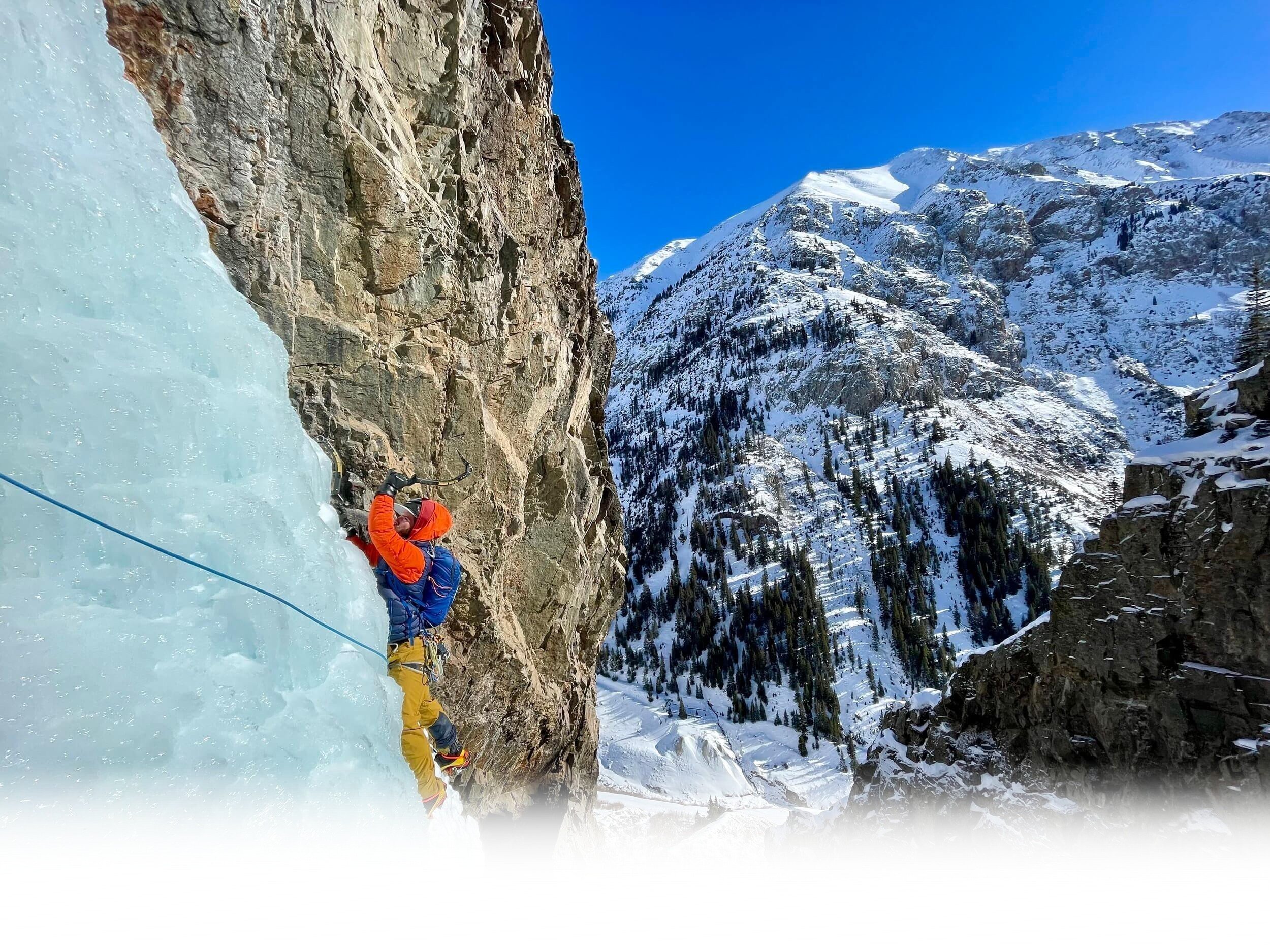
Multipitch ice climbing in the San Juan mountains
Come ice climbing in Ouray and climb classic frozen waterfalls across the San Juan mountains with local, AMGA certified guides. The town of Ouray, Colorado attracts ice climbers from around the world each winter due to the concentration, accessibility and quality of ice and mixed climbing routes at the Ouray Ice Park. Skyward Mountaineering offers guided ice climbing on the backcountry multipitch routes around Ouray as well as the surrounding backcountry areas, such as in nearby towns of Telluride and Silverton adding dozens more classic ice climbing routes. Nestled into the rugged San Juan mountains of southwest Colorado, with natural hot springs for après-climb relaxation, nearby resort skiing at Telluride, backcountry touring on Red Mountain Pass and a charming historical downtown, Ouray is the perfect basecamp destination for a winter ice climbing vacation.

Ice and mixed climbing
Routes range from WI3 to WI6 and M3 to M7
Previous toprope ice climbing experience required
It is also possible to spend a prep day in the Ouray Ice Park
Full day (8 hours)
All trips are custom bookings
Ouray, Colorado
7,792 ft / 2,375 m
Ephemeral Frozen Waterfalls
-
The Ouray Ice Park is undoubtedly the draw for many ice climbers, but the Ouray backcountry ice climbing routes are a great way to escape the crowds and put your ice climbing movement and multipitch systems to the test. In addition to instructional focused ice climbing in the Ouray Ice Park, we offer private guided ice climbing in Ouray.
Due to the lower elevation of Ouray (7,800 ft) it is common for routes to be highly seasonally dependent and may even come in and out of condition based on current cloud cover and temperatures, be prepared and flexible to seek out a rare classic if conditions line up.
Here are some of our favorite ice climbing routes that we guide in the Ouray backcountry:
Skylight Area (multiple routes from WI3 - WI5 and M4 - M8)
Dexter Slab (WI3+, II)
Gravity's Rainbow (WI4, II)
Cascade Falls (WI4, III)
The Ribbon (WI4, III)
Talisman (WI6, M6, III)
Birdbrain Boulevard (WI4, M6, IV)
-
At an elevation of 9,800 ft the ghost town of Eureka, Colorado is only a 10 mile snowy drive from the small mining town of Silverton and is home to a valley with world class ice climbing on either side of the cliffs above. It is common for high avalanche conditions to make this zone inaccessible throughout much of the winter, making it particularly rewarding when we are able to climb and explore in this incredible area.
Due to the higher elevation this is often one of the first backcountry waterfall ice climbing areas to reliably form in the state of Colorado. Skyward Mountaineering offers guided ice climbing in Silverton and Eureka in the winter as early as the first days of November with good conditions often persisting well into the spring with ascents possible through late April!
Here are some of our favorite ice climbing routes that we guide in the Eureka area:
Second Gully (WI3, III)
Captain Roos (WI4/5, III)
Stairway to Heaven (WI4, III)
The Calling (WI4, M4, III)
Hoser’s Highway (WI5, M5, IV)
Dukes of Hazzard (WI5, M6, III)
-
Bridal Veil Falls is a unique 400+ foot WI5+ ice climb in Telluride, CO. Three pitches take you through winding paths of clear tubes of steep ice, overhanging chandeliers and sometimes even tunneling terrain. The powerful hydraulics from the scenic power station above create a unique climb every winter, reliably forming by mid-December. This route is not to be missed for ice climbers ready to test their steep ice climbing abilities.
Depending on conditions, the route may be 3-5 pitches in length depending on the wandering nature of the route, and culminates at the power station. We rappel the route with multiple free-hanging abseils retracing our steps down the route. After a full day of difficult ice climbing, we often opt for a celebratory late lunch in downtown Telluride.
Bridal Veil Falls was first climbed in 1974 by Jeff Lowe and Mike Weis (with pound-in Snarg ice pitons and wooden straight shaft Chouinard piolets) and is one of the most iconic climbs in the region. Sitting atop the impressive frozen waterfall is a hydroelectric power station, built in 1907 to provide AC power from Blue Lake above to the Smuggler-Union mine in the cliffs below - it is one of the oldest power stations in the world!
-
These rugged peaks and deep canyons were once home to the Nuche (meaning The People, commonly referred to at as Ute), and the town of Ouray is named after the Tabeguache Chief Ouray (meaning Arrow) who signed a controversial treaty giving up the traditional land of the entire Nuche tribe. The towns of Silverton and Ouray later became booming mining towns in the late 1800s are are today popular tourist mountain communities. Once large and profitable mining towns such as Ironton or Eureka are now ghost towns with only the remnants of fallen buildings and mine shafts, but now they have become popular outdoor recreation hubs. In the wnter, these same valleys hold some of America’s finest natural ice routes - powerful frozen waterfalls, alpine gullies, and hidden multi-pitch routes tucked into the canyons, far from the crowds of the Ouray Ice Park.
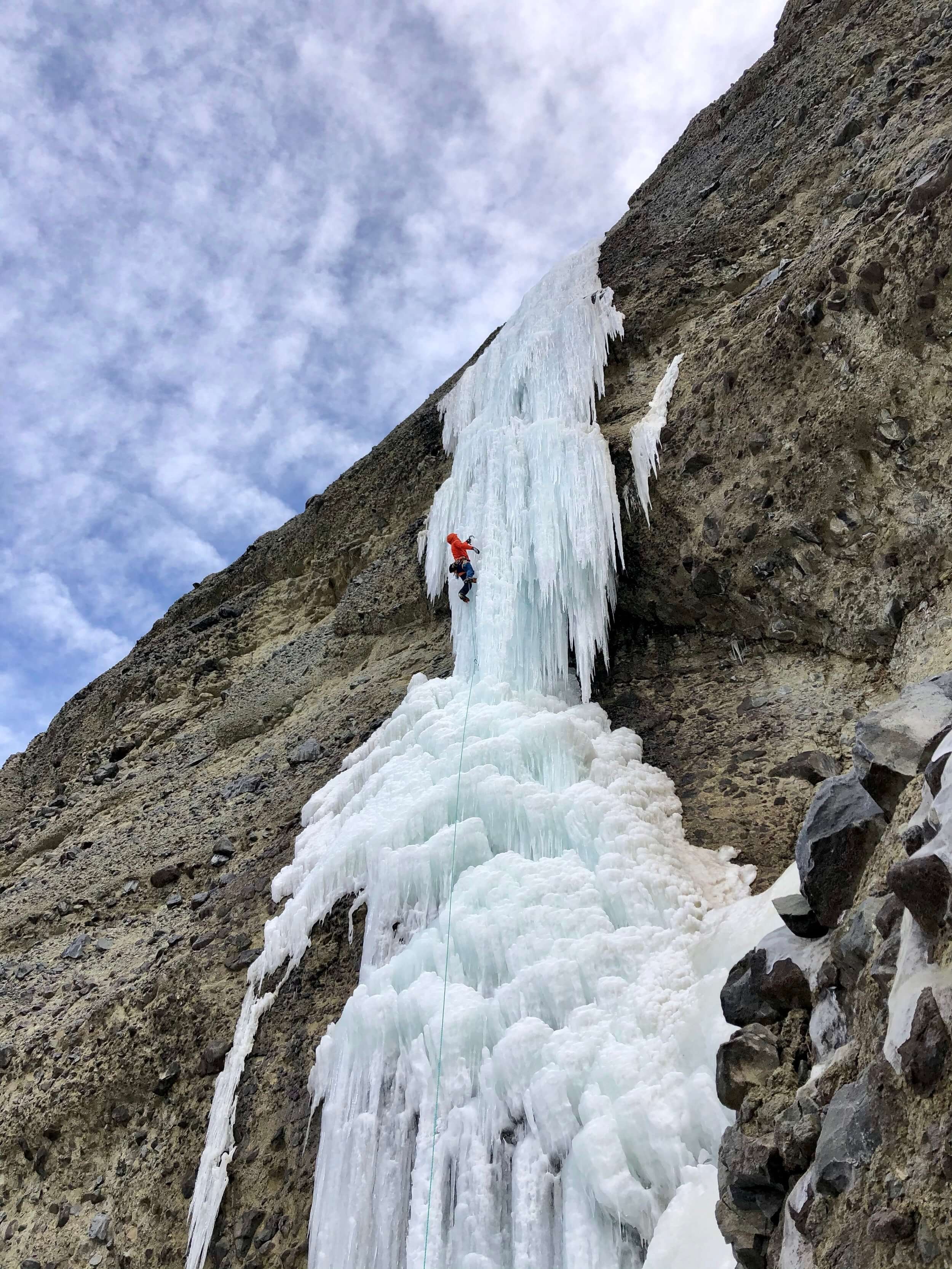
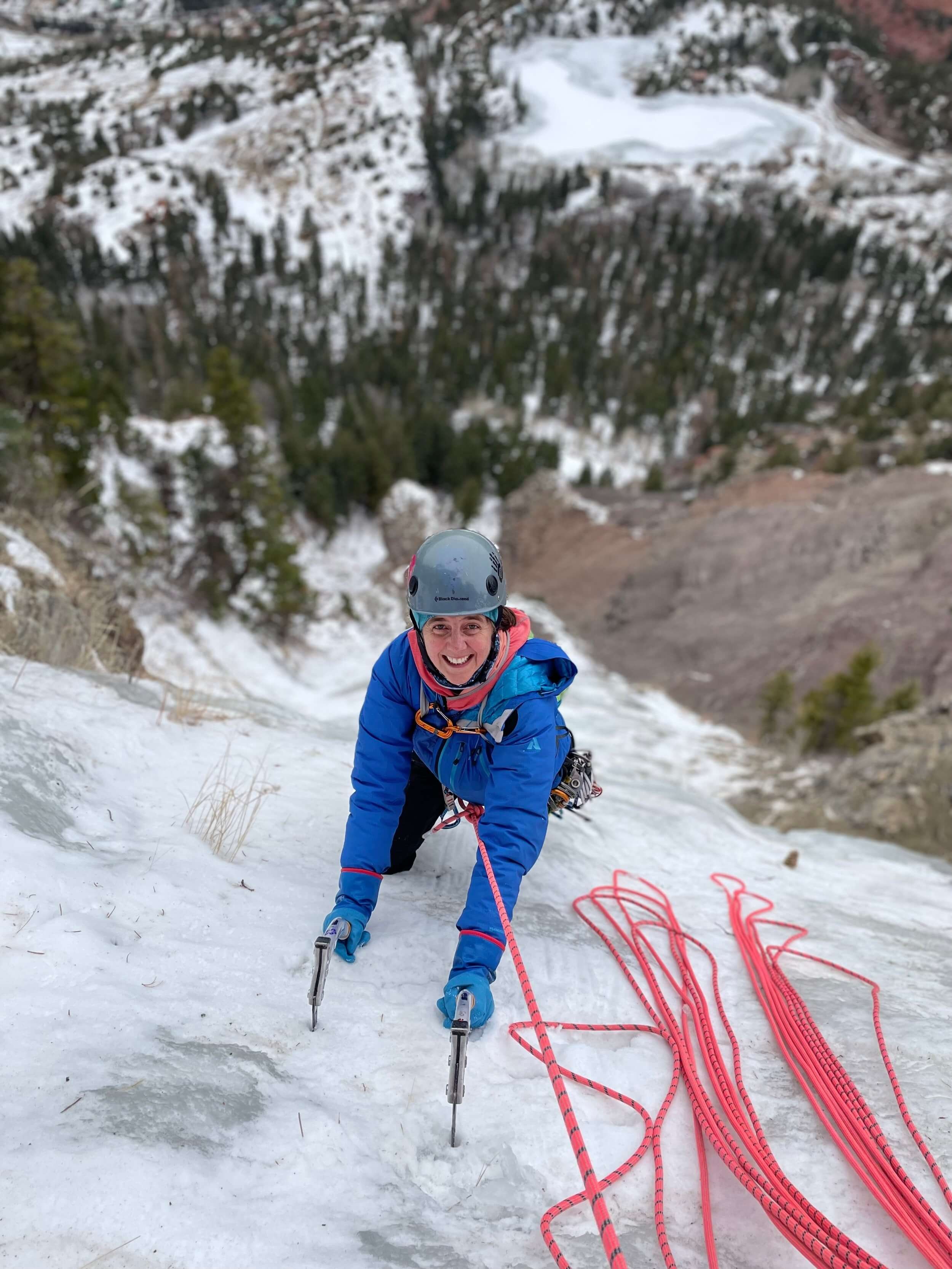
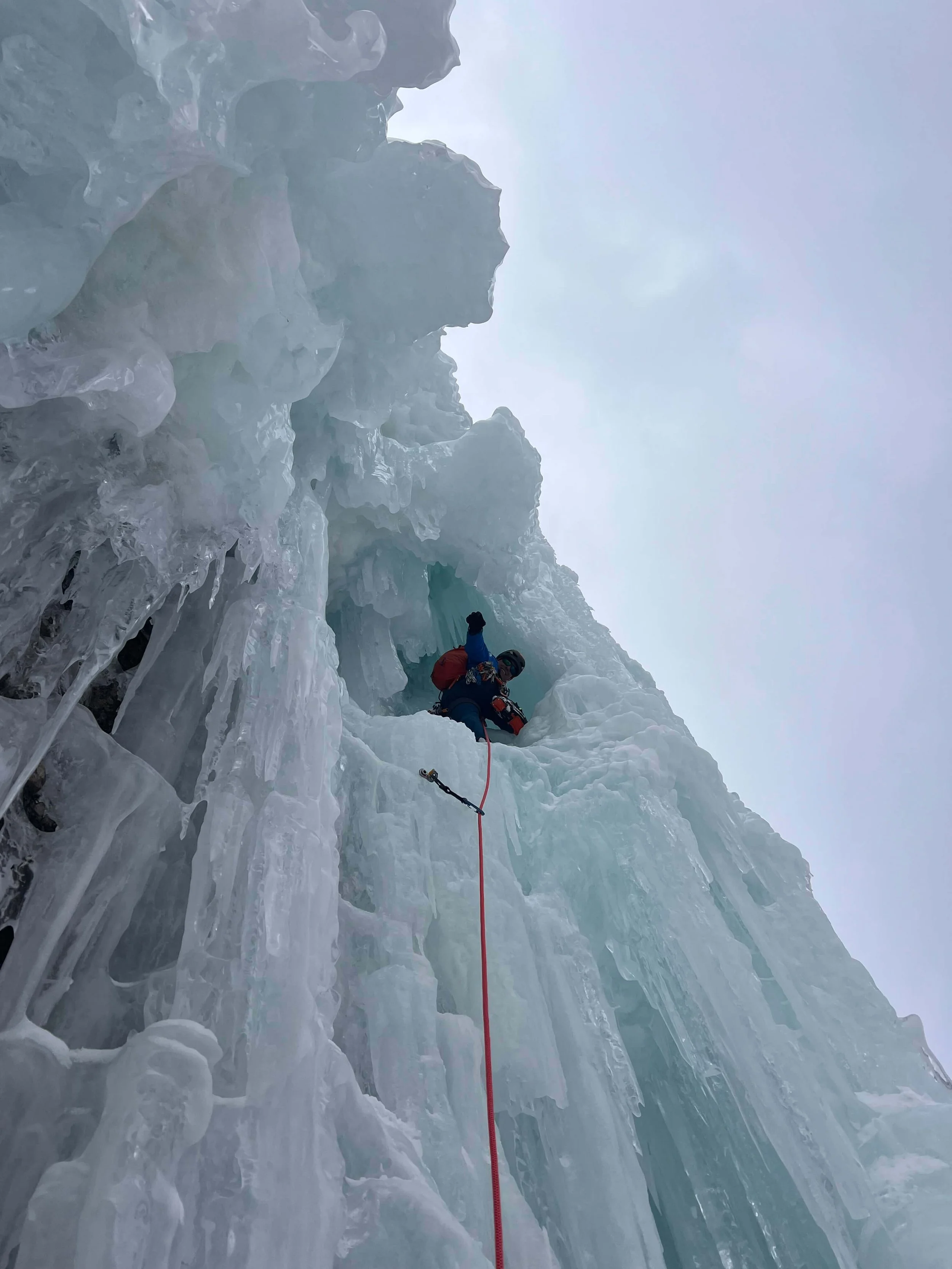


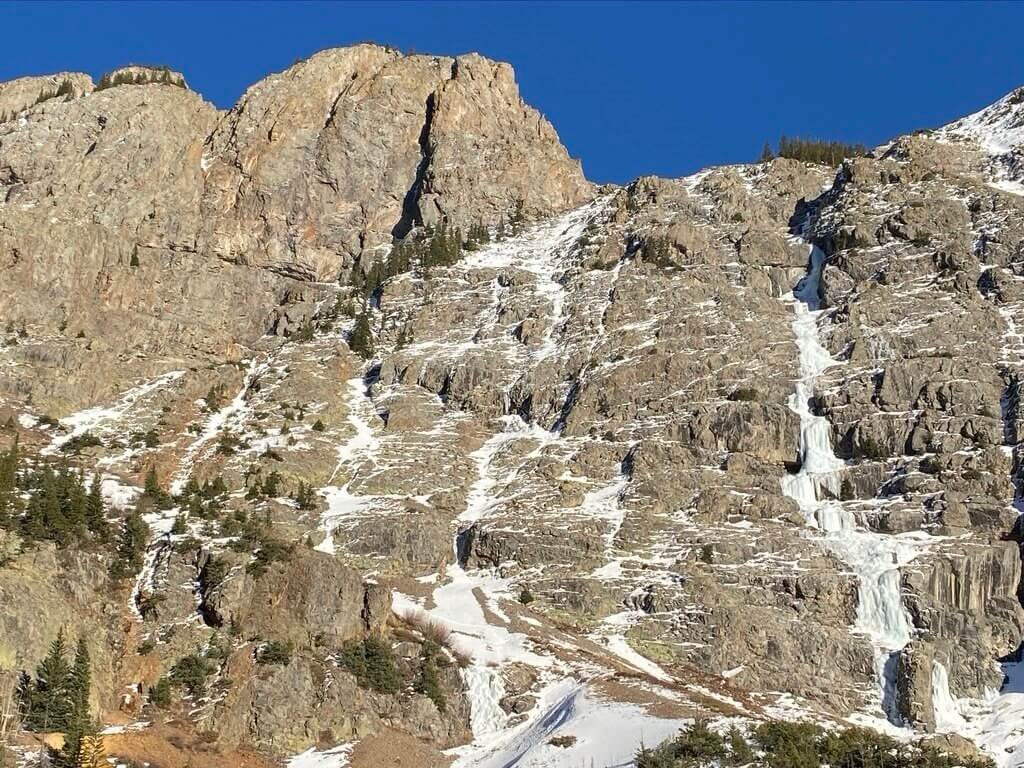


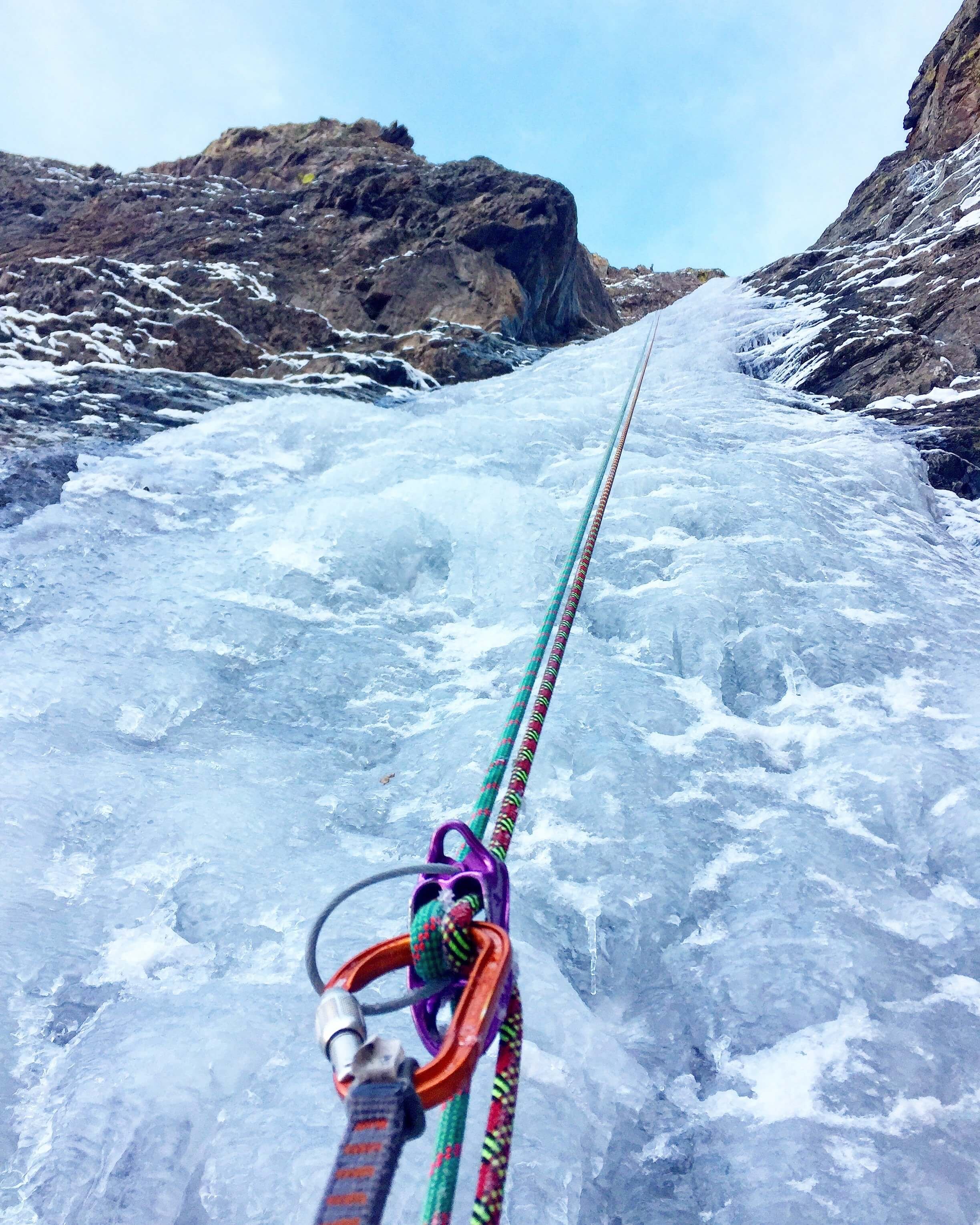


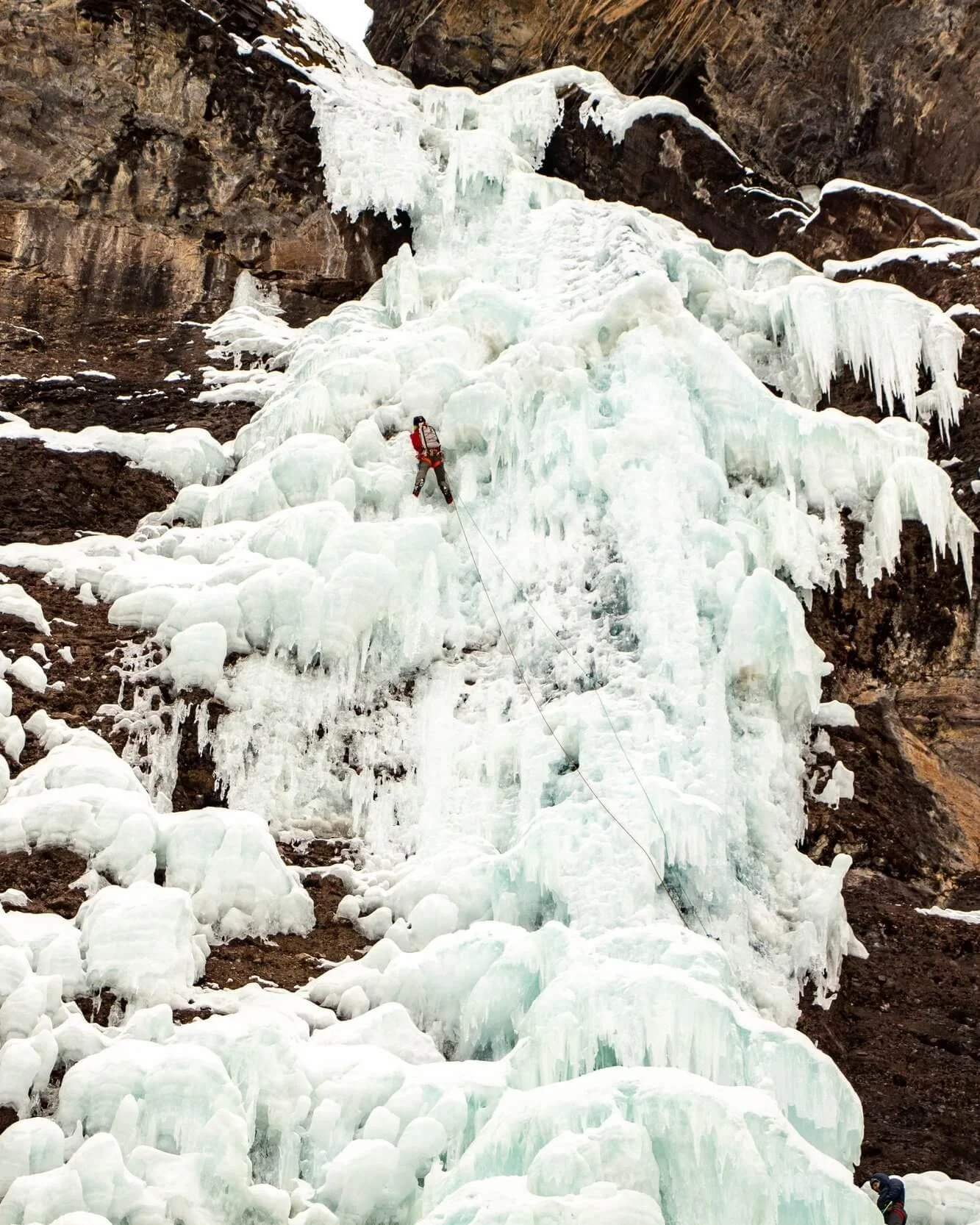

Explore frozen waterfalls on backcountry routes in Ouray and Silverton, a world class ice climbing zone in the heart of the San Juan mountains.
Backcountry ice climbing in Ouray and Silverton offers a unique blend of world-class winter climbing and rich cultural history in the heart of Colorado’s San Juan mountains. Whether you want to sample several classic ice climbing routes with a guide, learn efficient multipitch systems for ice climbing on big routes or climb a challenging ice or mixed climbing route on your tick list, Skyward Mountaineering guides are committed to supporting you in achieving your ice climbing goals. Founded in 1996, Skyward Mountaineering has been the longest continuously owned and operated guide service in the San Juan mountains and we remain a small team of highly trained and passionate ice climbing guides.
Frequently asked questions
Below are answers to common questions about backcountry ice climbing in Ouray, Silverton, and Telluride with Skyward Mountaineering:
-
Our backcountry ice climbing trips explore routes across the northern San Juan mountains, primarily near the towns of Ouray, Silverton, and Telluride, Colorado. It is possible to base in any of these mountain communities, though we recommend Ouray as a basecamp for backcountry ice climbing as it has the largest concentration of routes, there are numerous amenities in walking distance, and it is still possible to day trip to any of the routes in the nearby areas.
-
Yes - while we offer beginner friendly ice climbing in the Ouray Ice Park, our backcountry ice climbing trips in Silverton and Ouray are best suited for climbers with prior ice climbing experience. Climbers on backcountry routes should be comfortable toproping intermediate difficulty routes (WI3 - WI4) and be proficient with fundamental climbing techniques such as belaying and rappelling.
If you are new to ice climbing we highly recommend booking a day of guided ice climbing in the Ouray Ice Park or signing up with us for an ice climbing course. I is very reasonable to combine an ice climbing trip to Ouray with a day of learning in the Ouray Ice Park and then climbing a backcountry route in Ouray or Silverton.
-
The Ouray Ice Park offers easily accessible, human-made ice flows just minutes from downtown. Routes are approached from the top down so it is convenient to build toprope anchors and climb multiple routes in a day. Backcountry climbing involves natural ice formations, flowing water freezes slowly during the cold temperatures from either snow melt, a constant trickle of water, or even high flow waterfalls. Backcountry routes are often in remote terrain, have longer approaches, taller multi-pitch routes (up to 800ft tall in the San Juans), and a greater sense of adventure.
-
Ice climbing difficulty grades are based on the average steepness of the route. The grades typically have a WI (waterfall ice) rating from 1 - 6. 1 being a smooth low angle frozen river and 5 being vertical sustained ice. The majority of the routes in Ouray and Silverton are approximately WI4, meaning they may have sections of near vertical but are mostly around 75° - 80°. There are several introductory backcountry routes at the WI3 grade and also several challenging WI5 routes, such as the classic Ames Ice Hose or Bridalveil Falls in Telluride.
The ghost town of Eureka, outside of Silverton is known for it’s longer routes and has routes from WI3 to WI5. When avalanche conditions allow Eureka is a wonderful spot for climbers looking for more solitude and a more alpine experience.
Approaches to ice climbing routes in the San Juans range from 5 minutes to 1 hour. There are few routes that require a longer approach, though deep snow or more obscure/rare forming routes may involve longer approaches with ski flotation.
-
While all climbing has hazards inherent to the mountain environment, our guides are highly trained and experienced at managing objective and subjective hazards through careful planning, proper equipment, avalanche awareness, and conservative decision-making.
Our guides are highly trained and certified by the American Mountain Guides Association with technical guiding skills as well as with avalanche instruction through American Avalanche Association Professional Level avalanche courses. Additionally, as locals, we are able to precisely monitor conditions and weather to provide you the most up-to-date information.
We pride ourselves in having a staff of expert guides who are conservative decision makers with a safety mindset when evaluating avalanche and ice conditions. We are fully transparent and will explain our reasoning and evidence for when conditions are acceptable or not to climb in a given area. In fact, we encourage your questions and want to help you learn about risk management strategies so you can be a confident and competent climber.
-
Yes! Skyward Mountaineering puts a lot of value in working with you to personalize every guided climbing trip, so details like the start time, hiking pace, photos, climbing instruction, route linkups, etc can all be adjusted to meet your specific goals. Your guide will reach out in the days before the trip to discuss these logistics, please let your guide know if you have any questions or specific requests.
Additionally, our administrative staff are climbers and guides too and we’re here to support you through the whole process. If you have any questions before booking your guided climb or before the trip starts please reach out to us and we are happy to answer your questions.
-
We guide backcountry multi-pitch ice climbing at a maximum ratio of 2 climbers per 1 guide. If you would like to climb together as a larger group we can add another guide to the team. Contact us if you would like to climb in with a group of more than 2 people.
-
We have a detailed equipment list to help you prepare and pack for your trip. If you have questions about any of the gear please let us know, we’re happy to help make recommendations or clarify.
Skyward Mountaineering provides all of the technical group climbing equipment, this includes ropes, anchor material, protection, etc. Many of clients are experienced ice climbers and prefer to use their own equipment, though we do maintain a small fleet of personal gear for climbers on trips with us to borrow. We are also happy to have you use a new pair of ice tools or crampons if you’re interested in trying out different, modern tools. Please let the admin staff or your guide know ASAP if you expect to borrow personal climbing equipment such as backpacks, harness, helmet, belay device, carabiners, personal tether, etc.
-
The backcountry ice climbing in Silverton is some of the first ice to reliably form in the area due to the higher elevation. Generally locals start ice climbing in early November, though we recommend visitors plan their travel for more reliable conditions starting at the end of November. Ice routes in Ouray typically form up well by early December. Winter conditions stick around Ouray through mid to late March but ice climbing is still possible in Silverton and at higher elevations through the end of April. These higher elevation routes are a great prep for alpinists who are planning trips to the mountains of Alaska or Peru.
The Ouray Ice Park is reliably open from Christmas through the first week of March. It is possible with a cold start to winter that the Ice Park opens by mid December and if winter sticks around to stay open until the end of March, though it’s not a guarantee.
-
Sun or snow, we’re able to climb in the Ouray Ice Park during almost all weather events. Due to the nature of the terrain in the Ouray Ice Park, there is little to no avalanche hazard in the Ice Park, making it a reliable option. Many of the backcountry routes in Ouray have varying levels of exposure to overhead avalanches either on the approach or while on route, this is the largest factor in determining whether conditions are acceptable for climbing in the San Juan backcountry.
With an abundance of route options, our first choice when conditions prohibit us from climbing Plan A is to be flexible and adapt to the situation, choosing to instead climb a different but comparable route. In the rare event that the weather or conditions prohibit the team from ice climbing and your guide deems conditions to be unsafe/unreasonable we will work with you to reschedule your climbing trip.
For more information on our cancellation policy, please see our terms and conditions and contact us with any other questions.
-
If you know what dates you want to climb in the Ouray Ice Park, you can book your trip directly on our website. You can also get in touch to discuss your goals and ask any questions, we’re happy to help and send you a custom booking.
Though we often still have availability for last minute trips, please always reach out and ask, we highly recommend booking your trip at least 2 weeks in advance so we can guarantee your guide’s availability and ensure that you are confirmed with all the logistics.




